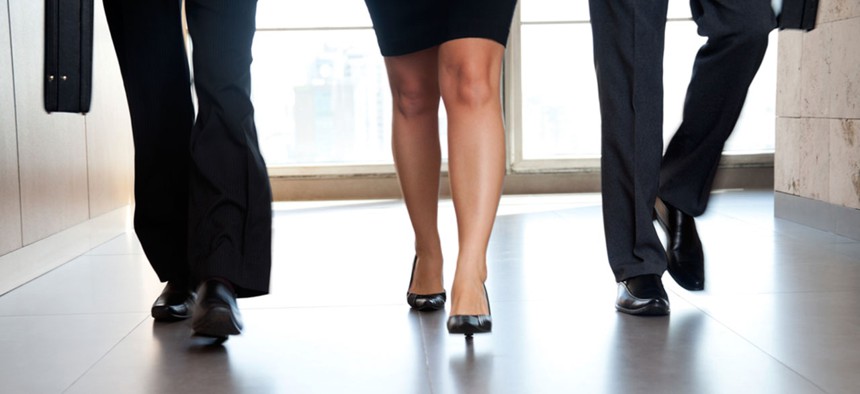
Tyler Olson/Shutterstock.com
In Cold Offices, It's All About Your Feet
At Berkeley, researchers are studying how wearing flip-flops changes buildings' air-conditioning needs.
When a tech company recently came to Stefano Schiavon at the University of California, Berkeley to test an air-conditioning system for its office, his mind went to flip-flops. The new system would blast cool air from the floor rather than the ceiling, and this being the Bay Area, and this being a tech company, Schiavon figured he couldn’t use the same old models researchers have been using since the 70s to study thermal comfort. (Yes, that is the name for the academic study of maintaining a building at just the right temperature.)
He needed to test people in flip-flops.
Feet, it turns out, are exquisitely sensitive to temperature. When you get cold, the blood vessels in your extremities are the first to constrict, which is your body’s way of preventing more heat loss. “You feel uncomfortable because your feet get numb or getting close to numb,” says Edward Arens, an architect at the University of Berkeley, who also studies thermal comfort. If building managers could heat or cool the feet alone, they could cut energy and costs. So at Berkeley, researchers are focusing on thermal comfort from the feet up.
Despite the outsized importance of feet in thermal comfort, footwear hasn’t been a big focus in the field. “Shoes haven’t gotten quite as much attention as clothing,” says Arens. Thermal comfort researchers have long had a trove of data on how well different types of clothing insulate the body. Not so with shoes. “Ten years ago, about all they had data for was men’s shoes with thick socks, going back to the 60s when everyone was wearing suits,” he says.
As someone who does not wear men’s shoes with thick socks, I confess to having hoarded a mini heater under my desk for the express purpose of warming my ankles. These heaters, Arens informed me, “are hated by the building managers.” They’re fire hazards, and they’re hugely inefficient because they blow hot air. Think about it: “Blowing” and “heat” actually have opposite effects. Blowing air over your feet cools them. So to warm your feet by blowing air, the heater has to blow extra hot air. And because that air mixes with cooler air in the room, it has to blow extra extra hot air. There is your fire hazard.
Arens has a better, more energy-efficient idea. He’s built a foot warmer that, unfortunately, looks a bit a foot oven. But inside, a lightbulb radiates heat onto your feet. No hot air. In tests among librarians working on the University of California, Berkeley campus, the foot warmers kept the librarians warm even when the room temperature dropped 4 degrees Fahrenheit. That actually cut heating costs in half, according to Arens. If your feet are warm, the rest of your body can easily compensate for those 4 degrees by burning a few more calories without much discomfort.
An even more direct way to heat your feet? Heated insoles. Arens showed me some battery-powered prototypes on his desk. The tiny batteries could draw wireless power from charging coils in a mat. Because the insoles would directly heat your feet, they draw just two watts of power—compared to the 1000 watts of hot air personal heaters can. (The foot warmers draw about 30 watts.) The prototypes are clunky though, not exactly something you can slip into a sleek pair of heels.
And that’s the challenge in selling office workers on these personal heating devices. People care about how things look. They don’t really care about saving their employers money on the energy bill. Arens said, not entirely jokingly, that the foot warmer could be better marketed for weight loss—you can stay comfortable while the rest of your body burns extra calories in the cold.
When it comes to cooling, feet need special consideration, too. What the tech company wanted Schiavon to test was an office-wide system that blew cool air at foot level. So Schiavon set up the system in Berkeley’s “controlled environment chamber,” a simulated office space where he has complete control over the chamber’s temperature, airflow, and humidity. He recruited students wearing flip-flops, plopped them in front of computers for three hours, and repeatedly surveyed them about their comfort levels.
Feet and ankles, Schiavon found, are even more sensitive to blowing air than previously thought. And this was an especially important finding for women, who are more likely to wear sandals and have bare ankles. To keep people from getting too cold, foot-level air conditioning requires fine-tuning, like getting a diffuser to slow cold air before it hits bare ankles. Raising the temperature of the whole office by a few degrees in the summer also helped. That would be the most energy-efficient solution. If everyone came in with flip-flops or sandals in the summer, the building could save on AC.
In the early days of air conditioning, offices were full of men in suits. We’ve come a long way already. From an energy perspective, “it’s been very good to relax the dress code,” says Arens. You can laugh now, but flip-flops? They might be next.






